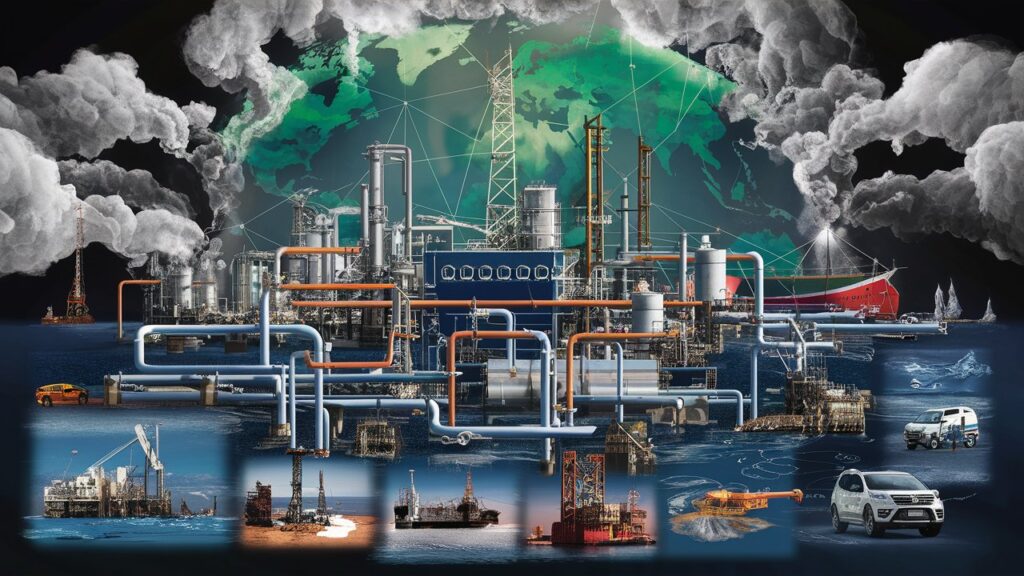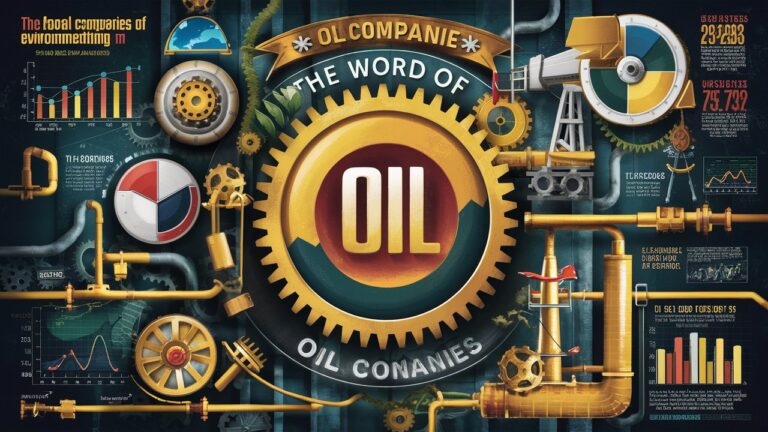Introduction
Oil companies form the backbone of global energy systems, driving economic growth while simultaneously facing unprecedented environmental and transition challenges. These complex organizations operate within a multifaceted ecosystem encompassing exploration, production, refining, distribution, and marketing of petroleum products that power transportation, heat homes, and serve as feedstocks for countless industrial processes. From multinational behemoths operating across dozens of countries to specialized national oil companies advancing domestic energy security, these entities navigate intricate geopolitical landscapes, technological innovation, and evolving market dynamics. The industry’s future is being reshaped by climate imperatives, renewable energy competition, and changing global demand patterns, creating both significant challenges and opportunities for transformation within the petroleum sector 38.
1. Investment Dynamics and Financial Structures
Oil companies offer diverse investment pathways, each with distinct risk-reward profiles. Direct participation through joint ventures allows investors to own a stake in specific wells, potentially yielding higher returns and substantial tax advantages. Through mechanisms like Intangible Drilling Costs (IDCs), investors can write off 70-85% of their initial investment in the first year, while Tangible Drilling Costs (TDCs) offer depreciation over seven years. The “Small Producers Exemption” provides a 15% depletion allowance on gross income 2. By contrast, indirect investments through stocks, Master Limited Partnerships (MLPs), or mutual funds offer liquidity but lack direct exposure to per-barrel production economics.
The risk landscape requires careful navigation, including potential complete capital loss from dry holes. Reputable operators like Aresco mitigate these risks by focusing on proven geological basins with strong production histories rather than frontier exploration. Diversification across multiple projects and basins is crucial, mirroring strategies employed by exploration and production (E&P) companies themselves. The timeline for returns varies significantly, with initial revenue checks typically arriving within 30-60 days after production begins, but achieving full cash-on-cash payout generally requires 18-24 months for wells with strong longevity profiles 2.
2. Global Market Dynamics and Geopolitical Influence
The United States dominates global production at 12.34 million barrels per day, yet remains significantly import-dependent, sourcing 40% of its crude oil externally 3. This dependence creates complex geopolitical relationships, with primary import sources being Canada (28%), Saudi Arabia (13%), Mexico (10%), Venezuela (9%), and Russia (5%). The global reserve landscape is fundamentally shaped by national oil companies, which control 78% of proven reserves and 58% of production, while international investor-owned corporations manage the remainder 3.
Petroleum product distribution reflects modern consumption patterns: 46% for gasoline, 20% for diesel, 8% for jet fuel, 7% for propane, and 19% for other products including petrochemical feedstocks and industrial materials 3. Crude oil itself varies significantly in quality, classified primarily by viscosity (“light” versus “heavy”) and sulfur content, characteristics that substantially impact refining complexity and end-use applications. Price volatility remains an industry hallmark, driven not only by immediate supply-demand imbalances but also by expectations about future disruptions, especially in geopolitically unstable producing regions 3.
3. Exploration and Production Operations
The drilling lifecycle encompasses seven methodical stages beginning with rig site preparation, including access road construction and environmental safeguards. The actual drilling phase deploys advanced techniques like rotary drilling, directional drilling, and hydraulic fracturing to access challenging reservoirs. Subsequent phases involve cementing casing strings to prevent groundwater contamination and ensure well integrity, followed by comprehensive pressure testing 4.
Well completion involves installing production tubing and perforating the casing to enable hydrocarbon flow. For unconventional reservoirs, hydraulic fracturing injects high-pressure fluid to create fractures that enhance hydrocarbon recovery, with increasing emphasis on fluid recycling to reduce environmental impact. The final production phase can extend decades before eventual well abandonment, involving permanent plugging and comprehensive site restoration 4. Offshore drilling presents additional engineering challenges, accessing significant subsea reserves in increasingly deeper waters using sophisticated floating platforms capable of operating in extreme marine environments.

4. National Oil Companies: Strategic Case Study
Uganda National Oil Company (UNOC) exemplifies the strategic role of state-owned entities in resource development. Established under Uganda’s Petroleum Acts of 2013, UNOC manages the government’s commercial interests across the value chain. Its 15% participating interest in the Tilenga (190,000 bpd peak) and Kingfisher (40,000 bpd peak) projects represents a model of national participation in major developments 6.
The company’s mandate extends beyond profit generation to ensuring “sustainable exploitation” through environmental stewardship and local economic development. UNOC subsidiaries manage specific value-chain segments: Uganda Refinery Holding Company (URHC) oversees downstream infrastructure (40% refinery interest), while the National Pipeline Company (NPC) manages the country’s 15% stake in the 1,443 km East African Crude Oil Pipeline (EACOP) to Tanzania 6. This integrated approach balances revenue generation with energy sovereignty objectives, aiming to stimulate economic growth through job creation, infrastructure development, and local content opportunities while adhering to core values of safety, environmental protection, and continuous improvement.
5. Industry Careers and Workforce Dynamics
The petroleum sector offers diverse career paths spanning geosciences, engineering, field operations, and corporate functions. Technical specialists (petroleum engineers, geoscientists) typically require advanced degrees and command starting salaries exceeding $60,000 plus signing bonuses due to persistent talent shortages. Field positions like roughnecks (derived from the physically demanding nature of early drilling work) and roustabouts offer entry points without advanced education but require rigorous safety training and tolerance for remote postings 7.
Offshore rig workers face unique living conditions—often described as comparable to college dorms—with 12-hour shifts during typically 14/21 day rotations. Comprehensive safety protocols govern all operations, with continuous training and emergency drills addressing hazards from high-pressure equipment to hydrocarbon handling. The industry provides substantial compensation reflecting demanding conditions, including benefit packages encompassing health insurance, retirement plans, and frequently rotational schedules yielding approximately six months annual leave 7. Major employment hubs cluster near producing regions: Houston for corporate functions, Prudhoe Bay for Arctic operations, and Alberta for oil sands development, with significant opportunities in emerging producers like Uganda.
6. Environmental Considerations and Sustainability Transition
Oil extraction poses substantial environmental challenges including potential groundwater contamination, habitat disruption, methane emissions, and carbon dioxide contributions to climate change. Modern regulations require comprehensive site restoration post-abandonment, though legacy issues persist. The industry faces increasing pressure to reduce flaring (still practiced extensively in some regions) and implement technologies like carbon capture 38.
The energy transition presents both existential threats and transformation opportunities. Natural gas has gained prominence as a lower-carbon transition fuel, especially following the shale revolution. Companies increasingly invest in renewable technologies, biofuel development, and geothermal applications leveraging drilling expertise. Sustainability metrics now influence investment decisions alongside traditional reserve-based valuation, accelerating initiatives like methane leak detection, electrification of operations, and integration of lifecycle emissions accounting 8.
Conclusion
Oil companies operate within an extraordinarily complex global system balancing geological uncertainty, capital intensity, technological innovation, and evolving societal expectations. Their operations—from drilling engineering to royalty management—underpin modern economies while facing unprecedented pressure to decarbonize. As national entities like Uganda’s UNOC develop resources with integrated economic development objectives, and international majors navigate energy transition imperatives, the industry demonstrates remarkable adaptive capacity. Understanding their multifaceted operations—financial structures, technical processes, and workforce ecosystems—provides crucial insight into global energy systems that will continue evolving amid the renewable transition. The most successful entities will likely be those that leverage core competencies in subsurface engineering while innovating for a lower-carbon energy future 68.
Frequently Asked Questions
1. How long will global oil reserves last?
Proven reserves total approximately 1.6 trillion barrels globally. At current consumption of 90 million barrels per day, this represents roughly 50 years of supply. However, technological advancements continuously improve recovery rates from existing fields and enable economic production from previously inaccessible resources, effectively extending this timeline 3.
2. How dependent is the U.S. on foreign oil?
The U.S. imports approximately 40% of its crude oil despite being the world’s largest producer. Over half these imports originate from Western Hemisphere sources, primarily Canada (28%), with significant volumes from Saudi Arabia (13%), Mexico (10%), Venezuela (9%), and Russia (5%) 3.
3. What are oil and gas royalties?
Royalties represent payments to mineral rights owners, typically 12.5–25% of the value of extracted resources. These payments compensate owners for resource extraction without requiring their direct involvement in operations. Payment frequency (monthly/quarterly) and calculation methods vary based on lease terms, production volumes, and commodity prices 2.
4. What career opportunities exist in oil and gas?
Positions range from petroleum engineers and geoscientists (requiring advanced degrees) to field roles like roughnecks and roustabouts accessible through vocational training. Competitive compensation reflects industry demands, with new graduates earning >$60,000 plus bonuses, and rotational field positions offering substantial time off alongside comprehensive benefits 7.
5. What environmental challenges does drilling pose?
Key concerns include potential groundwater contamination, habitat disruption, methane emissions, and carbon emissions. Modern operations implement stringent safeguards including multiple casing strings cemented to prevent aquifer contamination, closed-loop drilling fluid systems, and comprehensive site restoration post-abandonment. Industry faces increasing pressure to eliminate routine flaring and reduce operational emissions 48.
